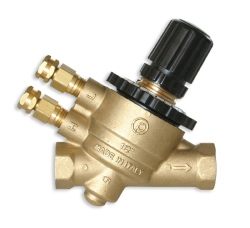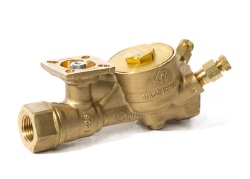Enjoying the benefits of PICVs

With BSRIA’s recent prediction that the market for PICVs (pressure-independent control valves) is set to grow rapidly, it seems that the strengths of PICVs are finally being acknowledged across the industry. Nick Martin of Marflow Hydronics looks at what benefits PICVs really bring to piped services.
Earlier this year BSRIA conducted a study on hydronic controls that forecasted the growth of pressure-independent control valves (PICVs) will nearly double from 2013 to 2018.* One of the key reasons the study applies to this rapid growth is the industry’s strong impetus to improve energy efficiency. The benefits of PICVs are being noticed more and more, and no doubt this trend will continue for years to come.
PICVs are multi-functional valves that combine the operation of three different valves in one convenient and compact unit. The PICV acts as a differential-pressure control valve, a regulating valve and a 2-port control valve — all in one. Using these valves in a commercial heating or cooling system can cost effectively optimise comfort levels, reduce ongoing energy consumption and also vastly improve the efficiency of the system.
Using PICVs
 |
| PICVs act as a differential-pressure control valve, a regulating valve and a 2-port control valve — all in one. |
From my perspective, by far and away the biggest benefit offered by PICVs is maintaining valve authority at part load. Buildings very rarely operate at their design duties. Maintaining control-valve authorities at all operating conditions means that fluctuation in comfort temperature is minimised and, critically, return-water temperatures are kept at their design values. Maintaining design ∆T means that the plant can operate most efficiently.
That’s a huge advantage, but there are many other great benefits to using PICVs in piped services. For starters, the selection of PICVs is greatly simplified when compared to using traditional 2-port control valves.
It’s probably fair to say that very few traditional 2-port systems had correctly sized control valves throughout. The complex calculations that must be performed to set up the system are difficult to work out in the first place; if any changes then need to be made, the system becomes even harder to manage. However, in comparison, when working with a PICV system it is very difficult to incorrectly size the control valves. None of the calculations that were a vital part of the more traditional systems need to be made anymore, and it becomes not only an easier system to set up and commission but also to maintain and modify in the long term.
PICVs also, as with any 2 port valve, enable the use of variable-speed pumping, and their use makes setting up and controlling the pump simpler. To go back to BSRIA’s cited reason for the growth in the product, PICVs aid the most energy-efficient way of controlling the pump, and that is via a remote sensor. The use of PICVs makes commissioning the system as simple as it can be, set up to a known minimum pressure.
To make it even more efficient, if rotary-styled PICVs are used, then commissioning can be done completely remotely. The PICVs in this case can be pre-set via BACnet to the building management system controller to enable remote commissioning. Remote commissioning reduces time, costs and energy as it enables adjustments to be made to a water system from any location in the world and at any time; it also eliminates the need for more manual labour when both initially commissioning the system and when changes need to be made.
 |
| Rotary PICVs can have their settings controlled via a building-management system. |
Balancing
Another great benefit is that PICVs allow water systems to be balanced dynamically. This means that the system is balanced only by limiting the water that can flow to each consumer, no system balancing is required. Furthermore, as each PICV includes differential pressure control, changes in system pressure should not affect the balance. This means that systems can be balanced in sections before they are fully complete. It also means that existing systems can be extended or modified without re-balancing.
When using PICVs, designs are also simplified. One standard detail can be used for the valve arrangement for any size of consumer. Also, fewer valves are needed in the system as there is now no requirement for system commissioning valves or differential-pressure controllers. These functions are all incorporated in the PICV.
The benefits that PICVs bring are numerous, and it is great news that BSRIA finally predicts the growth of the product. Their use not only increases the energy efficiency in a system, it increases efficiency all round and makes all elements of the system simpler to use.
Nick Martin is technical manager with Marflow Hydronics.







